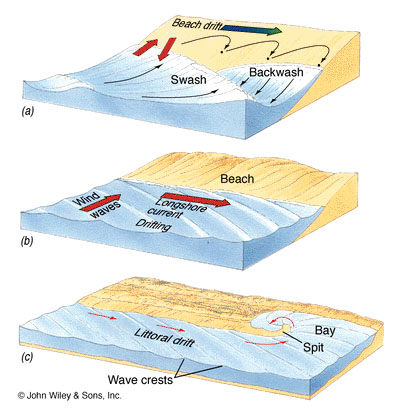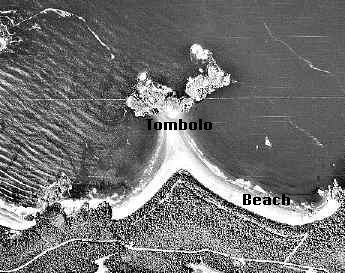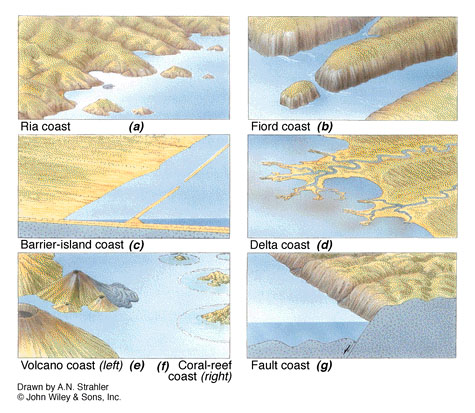
Shoreline - a linear clastic deposit characterized by being at the
water-land
boundary.
Shore (beach) - strip of land closest to the water affected by wave
action.
Wave terminology:
Constructive interference: wave crest or troughs match up with each other; are in phase. Wave amplitude gets larger.
In the open ocean, motion is circular, or oscillatory with no net forward motion.
As a wave travels across the ocean, the seafloor is well below wave base. However, as the wave approaches the shore, the seafloor rises and intersects the wave base. This causes the wave to slow since it looses energy interacting with the seafloor sediments. Waves behind it pile up on the slower moving waves causing the wave to increase in height and to decrease their period and wavelength.
As the wave continues shoreward, the crest moves faster than the base; this causes the wave to break. Motion in this surf zone transports material forward in a translatory motion.
Water moves up the beach face as swash and comes off the beach as
backwash.
Wave Currents
Like all waves, waves in the ocean can be reflected and refracted.
Refraction happens when deep water, fast-moving waves are slowed down when the seafloor rises above the wave base. The wave direction is diverted into the slower moving media. In other words, waves that approach the beach at an angle are diverted so that very near the shore they approach almost parallel. This change in direction results in the formation of a longshore current.
Once a wave has hit the beach (or any other obstacle) and comes off it, it can be reflected.
If the backwash coming off the beach is great, a riptide may develop in which there is a strong current flowing towards the ocean. A major cause of swimmer deaths each year.

Tides
Twice daily rise and fall of the ocean surface caused by the gravitational attraction of the moon. Water on the side of the earth facing the moon is pulled toward the moon by gravity resulting in a high tide. Water on the side of the earth away from the moon is also at high tide since the net gravitational attraction is less and the earth is spinning. At 90° angles to the earth-moon line, the tides will be low. Rising tides are called flood tides whereas falling tides are called ebb tides.
Tidal range is the difference in elevation between high and low tide and can be as high as 20 meters (Bay of Fundy, Nova Scotia).
Tidal attraction also affects the earth, but these tides are only on
the order of centimeters at most.
Coastal Erosion
Wave erosion is the most significant erosive mechanism along the coasts.
E.g., An average of 14,000 waves strike a coast each day. A 2 meter tall wave produces about 15 metric tons (~2000 pounds/foot2) of force on the exposed shoreline.
Factors affecting wave erosion:
Sediment is transported on the beach face as beach drift or in the
longshore current (longshore drift).


Anthropomorphic influences on coastal processes:
There are two major types of coasts:
Barrier Islands
Very long, narrow islands that are thought to have formed initially as spits. Now protect the coast and act as natural breakwaters. E.g., Cape Hatteras and Padre Island. Special example of Willoughby Spit.
Southern Florida and Coastal Hawaii have another type of coastline - one characterized by organic coasts. Southern Florida has an extensive coastline in which mangroves have extended the coast hundreds of meters to kilometers from the initial point. Some coasts are also dominated by coral reefs.
Reefs evolve through three stages:

Eustatic - pertains to a simultaneous, worldwide change in sea level.
Since the last Ice Age (~10 ka), sea level has risen approximately 130 meters.
Local sea level changes can arise from groundwater withdrawal (Galveston Bay, TX).
Global sea level is thought to be rising because of global warming which would: